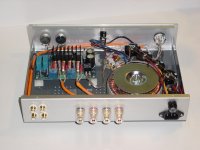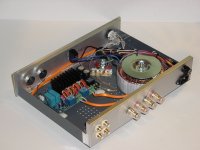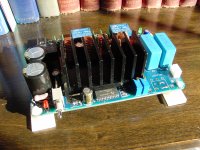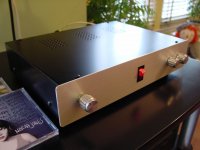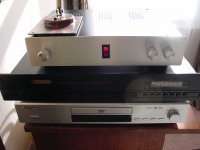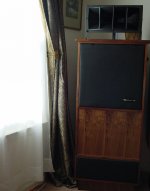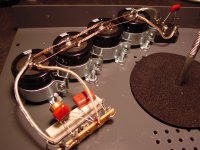Not sure what you are asking, but if you ask why there is not pot, maybe it is so you can use externally mounted pots, like on a chassis. I have one here pictured that I took the CTR pot off and bridged the connections. Then I used external individual pots mounted on the faceplate as shown. Works very well. This is the T1 80 watts @ 8 ohms, just finished yesterday. I am quite pleased with the HiFimeDIY product, it is crystal clear and extremely quiet, black background as they say. Breaking in now. Thanks hifimediy!
Attachments
As you say it worked before you put it on a chassis.
So maybe you have accidentally shorted connections.
Check speaker and power connectors.
This is of course what I'll do. Thank you for bringing me back to logic. First, I'll see if I can get the board to power up with the speaker output connectors disconnected.

Not sure what you are asking, but if you ask why there is not pot, maybe it is so you can use externally mounted pots, like on a chassis. I have one here pictured that I took the CTR pot off and bridged the connections. Then I used external individual pots mounted on the faceplate as shown. Works very well. This is the T1 80 watts @ 8 ohms, just finished yesterday. I am quite pleased with the HiFimeDIY product, it is crystal clear and extremely quiet, black background as they say. Breaking in now. Thanks hifimediy!
Beautiful build!
Will you be able to post some SQ comparisons to your Arjen amp? I'm sure lots of us would appreciate it.
Thanks.
Rod
Hifimediy, would be possible to make a T4 paralleled version (similar to T2)?It's TC2000/2001 + STA517B, not paralleled (similar to T1).
Power output would be doubled!
Hifimediy, what about making a really high-end two-channel amp based on TC2000/2001 + STA517B (or other chips if there are any even better alternatives)and including SMPS? I don't mean using some exotic overpriced parts but using standard high quality parts and everything what would get the best from the chips and make the resulting amp really outstanding. There could be a high-quality input buffer, optimised PCB layout, several very low ESR el-caps close the the power stage, ceramic bypass caps very close to the power stage, short, wide and symetrical power lines, high quality film caps and output inductors, etc. The complete amp module incl. high quality SMPS should be mounted on an adequately sized, easy to mount heat sink. Such complete module would be easy to use in final application - user would have to place this module into some case and connect only power, input signal (optionally going through a pot or other volume control) and speaker terminals. Maybe you could produce it even as a complete (boxed) high quality stereo amp (for non-DIY'ers).
I know your existing products are already very good and simply excellent for the price but I believe it is possible to get even more from these excellent Tripath chips.
What do you and other members think? Is this a bad idea?
I know your existing products are already very good and simply excellent for the price but I believe it is possible to get even more from these excellent Tripath chips.
What do you and other members think? Is this a bad idea?
Connexelectonic produces a fully assembled TA3020 (SMPS + power amp) on a single PCB, so you only have to connect input signal, speaker terminals and main AC voltage.Hifimediy, what about making a really high-end two-channel amp based on TC2000/2001 + STA517B (or other chips if there are any even better alternatives)and including SMPS? I don't mean using some exotic overpriced parts but using standard high quality parts and everything what would get the best from the chips and make the resulting amp really outstanding. There could be a high-quality input buffer, optimised PCB layout, several very low ESR el-caps close the the power stage, ceramic bypass caps very close to the power stage, short, wide and symetrical power lines, high quality film caps and output inductors, etc. The complete amp module incl. high quality SMPS should be mounted on an adequately sized, easy to mount heat sink. Such complete module would be easy to use in final application - user would have to place this module into some case and connect only power, input signal (optionally going through a pot or other volume control) and speaker terminals. Maybe you could produce it even as a complete (boxed) high quality stereo amp (for non-DIY'ers).
I know your existing products are already very good and simply excellent for the price but I believe it is possible to get even more from these excellent Tripath chips.
What do you and other members think? Is this a bad idea?
A similar pre-assembled kit from Hifimediy would be very interesting, but I don't know if Hifimediy has got the know how for project and building a SMPS.
Imho a complete boxed stereo amp would get no sense, the price would raise up too much and here the target is the diyer, not the end customer...
My 2 cents, of course
Don Jerry: Thank you for your response. I am aware of the complete TA3020 based amp from Connectelectronic. But I have read several times that TC2000 has somehow better sound signature (but this is probably subjective). I've also heard that a good input buffer improves the sound significantly.
I know there are several / many very good Tripath based amp modules from various sources available but I meant to design a new complete amp where every single detail would be treated carefully, leading to really outstanding result - and amp with great sonic performance, measurements, etc.
I think that complete boxed stereo amp, as an alternative to just the module, would not make much sense for DIY'ers but it could make sense for Hifimediy as he would reach a different market with the same product.
Just thinking loud...
I know there are several / many very good Tripath based amp modules from various sources available but I meant to design a new complete amp where every single detail would be treated carefully, leading to really outstanding result - and amp with great sonic performance, measurements, etc.
I think that complete boxed stereo amp, as an alternative to just the module, would not make much sense for DIY'ers but it could make sense for Hifimediy as he would reach a different market with the same product.
Just thinking loud...
Last edited:
Beautiful build!
Will you be able to post some SQ comparisons to your Arjen amp? I'm sure lots of us would appreciate it.
Thanks.
Rod
Comparisons are hard since the HiFimeDIY is still breaking in, but in all respects it is really good. It has assertive bass, has the mids magic WOW, has the airiness associated with T-class, it is extremely quiet, and has lots of power. Detail and focus are coming in as it breaks in. Quiet a bargain for what it is sold for. Hard to tell you which one is better, from a DIY standpoint, if you do it right the HiFimeDIY will payoff big time.
Here is the setup now with one of the speakers. It sounds amazing.
I will post the linear power supply schematic later, it is 1/2 the equation for good sound.
Attachments
I think that complete boxed stereo amp, as an alternative to just the module, would not make much sense for DIY'ers but it could make sense for Hifimediy as he would reach a different market with the same product.
Just thinking loud...
There really isn't much sense in making a consumer based amp based on chips that has been out of production for several years. Tripath unfortunately went belly up back in 2007, and production of Tripath chips already stopped back in 2003/4.
There really isn't much sense in making a consumer based amp based on chips that has been out of production for several years. Tripath unfortunately went belly up back in 2007, and production of Tripath chips already stopped back in 2003/4.
I understand your angle of view, on the other hand, if the old chips are available for DIY stuff then they are available also for consumer products, I think.
For example Sure Electronics also planned production of complete boxed amps.
I can imagine taking let's say T4, adding input buffer and some refinements, SMPS, and putting it all into some decent metal case.
Anyway, some time ago Steinar mentioned they were planning production of some complete boxed amp, if I recall it correctly.
Comparisons are hard since the HiFimeDIY is still breaking in, but in all respects it is really good. It has assertive bass, has the mids magic WOW, has the airiness associated with T-class, it is extremely quiet, and has lots of power. Detail and focus are coming in as it breaks in. Quiet a bargain for what it is sold for. Hard to tell you which one is better, from a DIY standpoint, if you do it right the HiFimeDIY will payoff big time.
Here is the setup now with one of the speakers. It sounds amazing.
I will post the linear power supply schematic later, it is 1/2 the equation for good sound.
Thanks a lot for your SQ feedback - does seem like you are very pleased with it.
With your big Altec horns any amp nastiness will sound rather awful so I take that as another plus with these amps.
I find your comments on the linear PS interesting. Seems that I've read many time on various Class D/T threads that SMPS is usually preferred. Could you enlighten us some more why you have gone the linear route and if you have been able to do any comparisons with the Meanwell supply that is recommended for these amps?
Believe me I am not at all criticizing your choice of linear. My gut instincts have told me that a good solid linear with a lot of high value capacitor should be better than the noise creating switchers. It's just that it seems like I've heard many statements to the contrary. Confusing!
Thanks very much for your important feedback. And I look forward to your PS schematic.
Rod
Power supply for 2xT3
Hello,
I'm planning to build 2xT3+2xPSU amp and it is my understanding that I need two power supplies in case if I use Meanwell S-350-48. Is it must to have and nice to have requirement?
Also, people have different opinions about SMPS vs. transformers. Is there a consensus what is better (size doesn’t matter)? If transformers are better, should I use one 800VA 30V or 2x300VA 30V? Is 30V most optimal (vs 28V or 32V)?
Thank you in advance.
Hello,
I'm planning to build 2xT3+2xPSU amp and it is my understanding that I need two power supplies in case if I use Meanwell S-350-48. Is it must to have and nice to have requirement?
Also, people have different opinions about SMPS vs. transformers. Is there a consensus what is better (size doesn’t matter)? If transformers are better, should I use one 800VA 30V or 2x300VA 30V? Is 30V most optimal (vs 28V or 32V)?
Thank you in advance.
Update on the T1, it has met and surpassed expectations. I love the way the bass goes down low, what a nice welcome performance from a T-class amp. The mid continues to do its magic.
I basically follow something very similar to the advanced linear solid state power supply described by TNT audio: Solid State Power Amplifier Supply Part 1
You'll see the schematic there on Part 3. Now keep in mind this power supply is for + 0 - , since this amp only uses + 0, then only use half the schematic on the transformer secondary side. Meaning, no negative voltage needed.
Additionally, I do some AC line filtering that is common to PC power supplies. I use an X class capacitor across the mains AC and Y class capacitors on each main line to ground. Also use a bleeder resistor across the mains. I do not use chokes in order to no affect transients surge and do not use power strip with surge suppression. I got that advise from the head engineer at Grapevine Audio, he really knows this stuff quite well.
You can also see it better in this picture, I feed the amp right off the soldering block.
whaleman, can you please post a schematic of the PSU side of your build? Looks interesting.
I basically follow something very similar to the advanced linear solid state power supply described by TNT audio: Solid State Power Amplifier Supply Part 1
You'll see the schematic there on Part 3. Now keep in mind this power supply is for + 0 - , since this amp only uses + 0, then only use half the schematic on the transformer secondary side. Meaning, no negative voltage needed.
Additionally, I do some AC line filtering that is common to PC power supplies. I use an X class capacitor across the mains AC and Y class capacitors on each main line to ground. Also use a bleeder resistor across the mains. I do not use chokes in order to no affect transients surge and do not use power strip with surge suppression. I got that advise from the head engineer at Grapevine Audio, he really knows this stuff quite well.
You can also see it better in this picture, I feed the amp right off the soldering block.
Attachments
Last edited:
Not sure what you are asking, but if you ask why there is not pot, maybe it is so you can use externally mounted pots, like on a chassis. I have one here pictured that I took the CTR pot off and bridged the connections. Then I used external individual pots mounted on the faceplate as shown. Works very well. This is the T1 80 watts @ 8 ohms, just finished yesterday. I am quite pleased with the HiFimeDIY product, it is crystal clear and extremely quiet, black background as they say. Breaking in now. Thanks hifimediy!
Hi, I am everytime really pleased in looking at your finished amps. Very fine and solid workmanship.
But are these big caps after the torroidal really needed ? If I have not read wrong, these could disturb if the specifications which are choosen in class-D amps are too big. But indeed they look impressing ...
help. my tk2050 suddenly my right channel now no sound why? have rescrewed all wires alr. there are still green and red light showing up.
edit: tried with different source, same problem. have swap speakers and same problem. suspect that right channel of my amp died but nth has burn marks or smell
edit: tried with different source, same problem. have swap speakers and same problem. suspect that right channel of my amp died but nth has burn marks or smell
Last edited:
Hello,
I'm planning to build 2xT3+2xPSU amp and it is my understanding that I need two power supplies in case if I use Meanwell S-350-48. Is it must to have and nice to have requirement?
Also, people have different opinions about SMPS vs. transformers. Is there a consensus what is better (size doesn’t matter)? If transformers are better, should I use one 800VA 30V or 2x300VA 30V? Is 30V most optimal (vs 28V or 32V)?
Thank you in advance.
Not to be rude, but you need to do your homework.
Search and find discussion in this thread about how trying one SMPS for both T3 channels results in audible noise, and how some models of Meanwell run their fans constantly and some don't.
You also apparently need to learn about linear power supplies from other places in DIY audio. Just for starts, a 30V transformer will give something like 42v dc after rectification, and besides what capacity you need to know how to put together the right combination of rectifier, capacitors, fuse, and inrush current limiting. Whaleman also gave a hint in the post after yours about the T1 supply he built, but you need to be sure you know enough about power supplies to understand what he is saying, for instance about +0- vs. +0.
Thank you for your reply.Not to be rude, but you need to do your homework.
Search and find discussion in this thread about how trying one SMPS for both T3 channels results in audible noise, and how some models of Meanwell run their fans constantly and some don't.
You also apparently need to learn about linear power supplies from other places in DIY audio. Just for starts, a 30V transformer will give something like 42v dc after rectification, and besides what capacity you need to know how to put together the right combination of rectifier, capacitors, fuse, and inrush current limiting. Whaleman also gave a hint in the post after yours about the T1 supply he built, but you need to be sure you know enough about power supplies to understand what he is saying, for instance about +0- vs. +0.
I did my best trying to find answers for my questions but I confess I didn't read each message in 120 pages.
I saw few messages where people were not happy with one power supply but it was not clear what setup they used and how much power they used. I'm building high efficient speakers (>95) and I don't listen music very loud. If T1 with STA110A can be powered with one 350 power supply I was thinking that maybe T3 with efficient speakers and ~30% of power can be powered with one brick as well, however I was going to buy two of them.
I’m aware that 30VAC will give me ~42VDC and 32VAC -> ~45VDC. T3 can handle 50VDC max. So, my question was about optimal power for T3 – is it 39, 42 or 45?
So far, I didn’t see consensus on SMPS vs. transformer question. Some people prefer transformers because of size, some say that sound is different.
And my last question was about one 700-800 transformer vs. two 300-350 ones. Will it affect sound somehow?
- Status
- This old topic is closed. If you want to reopen this topic, contact a moderator using the "Report Post" button.
- Home
- Amplifiers
- Class D
- New TK2050 board
